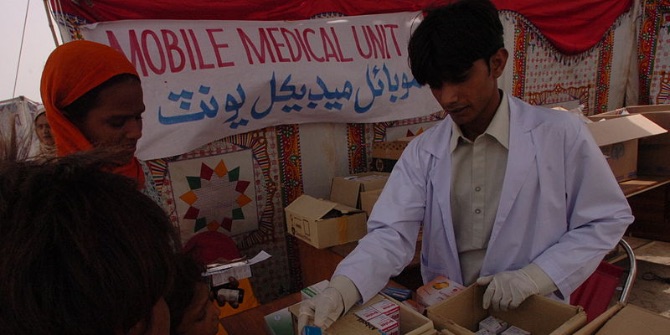Manisha Priyam analyses the Indian government’s decision to allocate coal resources to private players after three decades of state control and identifies reasons why a reasonable policy led to irregularities.
Since 1991, policy reforms in India that led to the lowering of state controls and reversing a dirigiste economy have been hailed globally.State monopoly over coal mines under the Coal Nationalisation Act of 1973 is one more element of the ‘old’ policy architecture. Dismantling control over this natural resource should have ideally met with a positive response, as a structural shift marking the maturing and consolidation of the reform process and for providing the necessary fillip to India’s growth story. Paradoxically, the first major step in this direction – the allocation of coal to private players after close to three decades of state control – has been a deeply contested process.
Policy gaps, lack of oversight, and opaque and wilful implementation have led to an erosion of the political consensus that allows business to be transacted in the country’s Parliament. Moreover, all parties other than the ruling Congress party have preferred protest and agitation to parliamentary deliberation. The result has been an impasse in the Monsoon Session of the Parliament—nearly 70 per cent of the scheduled business hours were lost due to shouting and sloganeering by the opposition and forced adjournment of proceedings.
In Parliament, as indeed in press conferences and television debates held in the absence of parliamentary deliberation, the furious squabbling has been poised around the report of the Comptroller and Auditor General (CAG) placed before the Parliament in August. The report observes that coal deposits have been distributed in an irregular and arbitrary manner by a screening committee of the government, rather than a market-led bidding procedure, and that the notional value of these ‘undue benefits’ is around 1.86 lakh crore rupees (or 1,86o billion rupees). The government itself indicated that it was in favour of auctions. But it cited difficulties in dismantling the old regime (mainly in terms of statutory amendments to the Coal Mines Nationalisation Act 1973 and the Mines and Minerals Development and Regulation Act of 1957) as the argument for persisting with allotments by a screening committee under the authorisation of the prime minister acting as the minister of coal between 2005-10, when a majority of these allocations were made.
Even if the government’s policy choice of allocation rather than bidding were accepted theoretically as having some basis in reason, and in law, there is no denying that there has been a lack of procedural oversight and discretionary allotments made. The government’s itself accepts this as its strongest investigative arm, the Central Bureau of Investigations (CBI), has filed charge-sheets against five of the companies that were allotted mines on the grounds of having concealed or misrepresented facts. Besides, in a clear case of conflict of interest, its ministers are said to have lobbied directly for allocations to companies where their kin or close associates had substantive stakes. The prime minister has defended his actions, averring that “allegations of impropriety are without basis and unsupported by facts” and taken full responsibility for actions of his ministry on the floor of the House. But in light of emerging facts, the image of India’s reform leader stands diminished. More seriously, there are questions as to why the prime minister should be left outside the net of accountability. The Public Accounts Committee of the Parliament, authorised to review the CAG Report, can call him for questioning if business resumes in the House.
There are significant reasons why the policy choice favouring a non-competitive allocation procedure was not completely misplaced. For one, an end-to-end, market-based competitive process would have been difficult given that there is government intervention in fixing the price of power, the ‘end use’ to which mined coal would be put. Besides, there are significant aspects of local variation that would have made the working of the ‘average pricing’ method adopted by the CAG in computing the presumed losses unworkable in actual practise. The most significant of these are the local difficulties in land acquisition owing to differences in ownership and possession, multiple pattas for any given tract, and entrenched Naxal control over large parts of tribal and forest land where coal mines are located. Other aspects of variation include the availability or lack thereof of road and/or rail networks and the capacity to elicit local labour cooperation.
Given this context, it was not unreasonable for the prime minister to have relied on the judgement of the “many participants in Screening Committee acting collectively”. Such a policy choice had a sound basis even in law. The landmark 1982 judgement of the Supreme Court in Sanjeev Coke Manufacturing Company v. Bharat Coking Coal Ltd. upheld these matters to be essentially those of state policy, “inherently inappropriate” for judicial review. Coal was viewed as a “material resource of the community”, capable of producing “wealth for the community”. According to the judgement, where competing social and economic factors have to be weighed, “legislative wisdom” must prevail. The prime minister reaffirmed this vision when he stated higher energy production and GDP growth rates to be the justification for his policy. Viewed against these ideals, however, the irregularity of allocations and the inability to exploit the mines even five or six years after allotment seem to be more than chance outcomes or procedural delays.
Firstly, the government did nothing to circumvent some of the anticipated procedural delays—namely forest and environmental clearances. While part of these come from state governments, pre-mining environmental clearances or forest clearances could have actually been facilitated by the centre through single-window clearances alongside allocations or by simply expanding the “collective wisdom” of the committee to include some more experts on these matters. Mending policy tangents and not just “rolling back nationalisation” should have been the role of a visionary leader. Think of the contingent nature of these allocations: if the ownership of the land above the mines happened to be with scheduled tribes, the clearance of the concerned district collectors would be required even after the allocations were made under a ministry led by the prime minister.
Second, since ‘allocations’ as a procedure were open to some amount of subjectivity (recognised by the prime minister as an issue in his August statement on the floor of the house), it is surprising that the policy did not conceive of any modality for supervision following allocations. It is notable that the current disclosures on irregularities have been made by persistent queries from parliamentarian Hansraj Ahir and complaints from him and other MPs leading to investigations by the CBI. This gap, and the fact that mines were given away without charging anything, form the basis of the charge against the government of causing a deliberate loss to the public exchequer. Simple instrumentalities such as long-term, revenue-sharing models between the government and the private players were one possible way of avoiding this.
Third, while the nationalisation of India’s coal mines in 1973 represented an act of ‘command’ politics under Indira Gandhi, and was a precursor to the build-up of authoritarian state power culminating in the 1975 emergency, the current approach did nothing to reverse the ills of nationalisation. On the ground, mafia stranglehold on transportation, casual labour, and now a large body of unemployed youth continues. Since the government hasn’t paid up many of its old dues to the community (for mines acquired earlier), the trust gap is wide. And in the absence of a land acquisition policy, the poor people who live on the ground above the mines hold on to it as their only means of livelihood.
Policy reversal seems unlikely now, even though the opposition Bharatiya JanataParty and a separate grouping of the Left parties as well as regional parties (the Samajwadi and the Telugu Desam) have called for scrapping of all allocations. Financial experts point out that since lending institutions have extended credit to many of the companies that were allotted the coal blocks, cancellation at this stage would strain the system excessively—‘coalgate’ may well turn out to be India’s ‘sub-prime’.
For policy analysts such as myself who had believed that the new policy architecture would increase the wealth of a very poor nation, rampant indiscretion in allotment of natural wealth for private profiteering is an example of how wealth is drained. Its consequences seem glaring when we realise that India’s poorest people reside at the sites of these coal mines – primarily in Jharkhand and Chattisgarh – and they continue to be the subject of policies that treat them as squatters not citizens.
About the Author
Manisha Priyam teaches Political Science at Gargi College Delhi University. She received her doctorate from LSE’s Department for International Development in 2012.
Manisha is a regular contributor to the India at LSE blog. See here for more posts.
Photo credit: Daniel Berehulak for the Los Angeles Times








